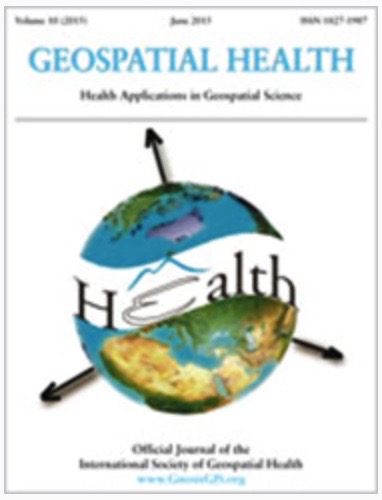Population dynamics and spatial structure of human-biting mosquitoes, inside and outside of houses, in the Chockwe irrigation scheme, southern Mozambique
Published: 1 May 2013
Abstract Views: 1667
PDF: 904
Publisher's note
All claims expressed in this article are solely those of the authors and do not necessarily represent those of their affiliated organizations, or those of the publisher, the editors and the reviewers. Any product that may be evaluated in this article or claim that may be made by its manufacturer is not guaranteed or endorsed by the publisher.
All claims expressed in this article are solely those of the authors and do not necessarily represent those of their affiliated organizations, or those of the publisher, the editors and the reviewers. Any product that may be evaluated in this article or claim that may be made by its manufacturer is not guaranteed or endorsed by the publisher.
Similar Articles
- Peter Nezval, Takeshi Shirabe, Design and implementation of a spatial database for analysis of wheelchair accessibility , Geospatial Health: Vol. 20 No. 1 (2025)
- Sarah Isnan, Ahmad Fikri bin Abdullah, Abdul Rashid Shariff, Iskandar Ishak, Sharifah Norkhadijah Syed Ismail, Maheshwara Rao Appanan, Moran’s I and Geary’s C: investigation of the effects of spatial weight matrices for assessing the distribution of infectious diseases , Geospatial Health: Vol. 20 No. 1 (2025)
- Carla Ippoliti, Marius Gilbert, Sabine Vanhuysse, Maria Goffredo, Giuseppe Satta, Eléonore Wolff, Annamaria Conte, Can landscape metrics help determine the Culicoides imicola distribution in Italy? , Geospatial Health: Vol. 8 No. 1 (2013)
- Yi-Lan Liao, Jin-Feng Wang, Gong Chen, Wei Du, Xin-Ming Song, Xiao Yun, Xiao-Ying Zheng, Clustering of disability caused by unintentional injury among 15- to 60-year-old: a challenge in rapidly developing countries , Geospatial Health: Vol. 8 No. 1 (2013)
- Kwang-Soo Lee, Kyeong-Jun Moon, Hospital distribution in a metropolitan city: assessment by a geographical information system grid modelling approach , Geospatial Health: Vol. 8 No. 2 (2014)
- Jia-Cheng Zhang, Wen-Dong Liu, Qi Liang, Jian-Li Hu, Jessie Norris, Ying Wu, Chang-Jun Bao, Fen-Yang Tang, Peng Huang, Yang Zhao, Rong-Bin Yu, Ming-Hao Zhou, Hong-Bing Shen, Feng Chen, Zhi-Hang Peng, Spatial distribution and risk factors of influenza in Jiangsu province, China, based on geographical information system , Geospatial Health: Vol. 8 No. 2 (2014)
- Hassan M. Khormi, Lalit Kumar, Climate change and the potential global distribution of Aedes aegypti: spatial modelling using geographical information system and CLIMEX , Geospatial Health: Vol. 8 No. 2 (2014)
- Luis E. Escobar, Andrés Lira-Noriega, Gonzalo Medina-Vogel, A. Townsend Peterson, Potential for spread of the white-nose fungus (Pseudogymnoascus destructans) in the Americas: use of Maxent and NicheA to assure strict model transference , Geospatial Health: Vol. 9 No. 1 (2014)
- Samuel F. Atkinson, Sahotra Sarkar, Aldo Aviña, Jim A. Schuermann, Phillip Williamson, A determination of the spatial concordance between Lyme disease incidence and habitat probability of its primary vector Ixodes scapularis (black-legged tick) , Geospatial Health: Vol. 9 No. 1 (2014)
- Marcos C. Ferreira, Geographical distribution of the association between El Niño South Oscillation and dengue fever in the Americas: a continental analysis using geographical information system-based techniques , Geospatial Health: Vol. 9 No. 1 (2014)
You may also start an advanced similarity search for this article.











